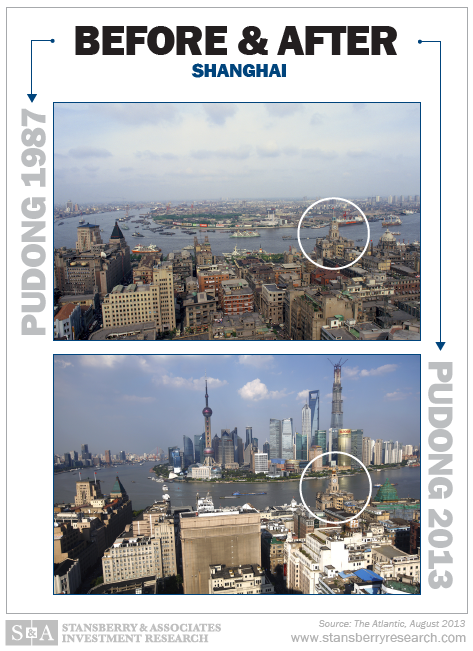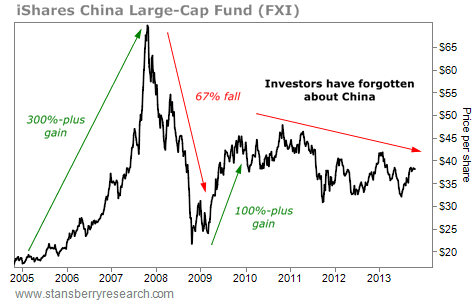 I wouldn’t have believed it was humanly possible if I hadn’t seen the growth in China with my own eyes…
I wouldn’t have believed it was humanly possible if I hadn’t seen the growth in China with my own eyes…
I first visited Shanghai about 20 years ago. I almost laughed out loud when a Chinese official in a small musty office told me his plans to develop a massive new financial district in sleepy Pudong, located just across the water.
This official worked for the Shanghai Lujiazui Finance and Trade Zone Development Company. He showed me a 30-foot by 15-foot table – a 3D master plan full of skyscrapers… maybe over 100 of them.
[ad#Google Adsense 336×280-IA]As I listened to him talk, I knew his proposal wasn’t possible – for anyone.
He was planning what seemed to be the greatest construction project in the history of mankind.
How could a bunch of inexperienced bureaucrats make that happen… and in such a short time frame?
I could hardly hold in my laughter as he explained this preposterous plan with a straight face…
But China had the last laugh.
The Chinese official in the musty office was right. His plan for Shanghai came true – and then some.
Words can’t even describe the transformation. Fortunately, I found an excellent “before and after” picture online of what this guy was talking about. It is unbelievable… but it really happened.
As you look at the picture below, use the “Big Ben”-style clock (circled) as your frame of reference. It doesn’t change from past to present. (You can view the original photographs here.)
 China’s growth has been crazy. And I wouldn’t rule out that its economy could overtake – even double – the U.S. economy by 2050.
China’s growth has been crazy. And I wouldn’t rule out that its economy could overtake – even double – the U.S. economy by 2050.
This doesn’t mean I’m a China “bull” – thinking everything China does is right. I’m also not a China “bear” – thinking everything China does is wrong. I am simply an investor looking for a way to make money.
And in all my years in the markets, I have learned one thing about China…
Sometimes, investors love China… They think it’s the next big thing, so they pour money into it. And sometimes investors hate China… They think it’s all a big fraud that will never amount to anything, so they take their money out of it.
I think the truth lies somewhere in between, leaving us room to make real money. Here’s how:
If you’re simply bold enough to buy when people think China will never amount to anything and sell when people believe China is about to take over the world, you can make a lot of money in Chinese stocks.
This chart of the iShares China Large-Cap Fund (FXI), which holds some of the biggest blue-chip companies in China, tells the story… In the last decade, China’s largest stocks have soared, crashed, and soared again. Now, they’re moving sideways.
 From 2005 to 2007, investors fell in love with China. Stocks soared by hundreds of percent. Then, during the 2008 financial crisis, nobody wanted anything to do with China. Stocks lost two-thirds of their value. But they recovered again in 2009 with a triple-digit gain.
From 2005 to 2007, investors fell in love with China. Stocks soared by hundreds of percent. Then, during the 2008 financial crisis, nobody wanted anything to do with China. Stocks lost two-thirds of their value. But they recovered again in 2009 with a triple-digit gain.
In recent years, Chinese stocks have moved sideways and down, so American investors have forgotten about them. They’ve given up on China. That gets me interested.
And the biggest names in China – the top 10 holdings in FXI – are dirt-cheap. These powerful companies are trading at a median forward price-to-earnings (P/E) ratio of less than 8. Take a look:
 I’m currently recommending buying China in a variety of ways in my True Wealth and True Wealth Systems publications.
I’m currently recommending buying China in a variety of ways in my True Wealth and True Wealth Systems publications.
But FXI is probably the safest, simplest way to “own” China, because it’s full of blue-chip Chinese companies. And right now, you can set up a pretty safe long-term trade with it…
Your upside potential could be triple-digit-percentage profits. And if you set a stop-loss at around $32, your downside risk is about 16%.
I suggest a $32 stop loss because FXI has bounced off of $32 a few times in the last two years. If it falls below $32, chances are the China trade isn’t working out in our favor.
I’m heading to China in a couple weeks to check out the opportunities. You will hear more from me about China then. Until then, check out FXI, which is one of the safest, simplest ways to gain exposure to Chinese stocks right now.
Good investing,
Steve
[ad#stansberry-ps]
Source: DailyWealth
